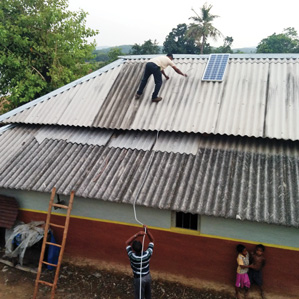An estimated 1.3 billion people around the world lack any access to electricity, but now researchers from MIT have developed a system that enables rural villagers who can afford solar panels to sell some of the output, providing both income for the owners and much-needed power for their neighbors.

The system, developed over two years of research and numerous trips to India, has at its heart a simple device that is smaller than a shoebox: a power management unit. This performs a variety of tasks, regulating how electricity from solar panels gets directed to immediate uses—such as powering lights and cell phones—or to batteries for later use. At the same time, it monitors how much power goes to each user, providing a record for billing without a need for individual meters.
MIT doctoral students Wardah Inam, SM ’13, and Daniel Strawser, SM ’12, supported by the MIT Tata Center for Technology and Design, spent much of this summer doing field tests of the system in a village in the Jamshedpur area in northeastern India. A few of the village’s houses already had small, simple solar power systems being used to run a few low-power LED lights and charge cell phones. After evaluation of test results, participants were slated to get permanent solar installations that would provide them an opportunity to earn revenue by selling excess power to neighbors without electricity.
Rather than bringing in a system designed by outsiders, Inam says, the idea is for locals to develop a system to meet their own specific needs and preferences. “We want to empower the people to build a grid,” she explains. While some in these villages can already afford to pay for solar installations at their homes, knowing they’ll be able to sell some of that power to other nearby homes through a “microgrid” could encourage these users to invest in larger systems at the outset. Meanwhile their neighbors, without having to pay any up-front installation costs, would get the benefit of power for lights and charging for an estimated cost of $2 to $5 a month—“less than what they pay now for lighting using kerosene or candles,” Inam says. “For the same amount, they’ll get better, safer lighting, as well as other services.”
“It’s a bottom-up approach,” says Strawser. Local users—who have already contributed to the design choices through their interactions with the team—get to decide what gets installed where and when.
Keep Reading
Most Popular
Large language models can do jaw-dropping things. But nobody knows exactly why.
And that's a problem. Figuring it out is one of the biggest scientific puzzles of our time and a crucial step towards controlling more powerful future models.
How scientists traced a mysterious covid case back to six toilets
When wastewater surveillance turns into a hunt for a single infected individual, the ethics get tricky.
The problem with plug-in hybrids? Their drivers.
Plug-in hybrids are often sold as a transition to EVs, but new data from Europe shows we’re still underestimating the emissions they produce.
Google DeepMind’s new generative model makes Super Mario–like games from scratch
Genie learns how to control games by watching hours and hours of video. It could help train next-gen robots too.
Stay connected
Get the latest updates from
MIT Technology Review
Discover special offers, top stories, upcoming events, and more.